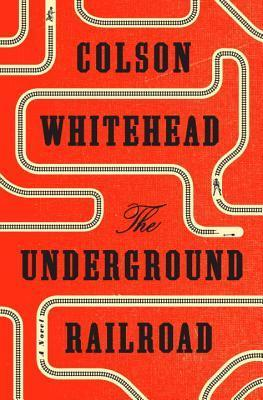Craft
Colson Whitehead’s Subterranean Odyssey
The author of The Underground Railroad discusses trauma, slavery and finding a voice for the year’s most acclaimed novel.

In The Underground Railroad, Colson Whitehead’s gripping new novel, we are introduced to a metaphor made manifest: an actual railroad, underground. A literal and literary engine for his incredible inquiry into slavery, humanity, and the true nature of America. When Cora is invited to leave, to escape the plantation where she has lived her whole life and take the titular train north, she climbs down the rabbit hole and through different states, both geographical and psychological. She runs through a world fueled by cruelty, ambivalence, and every so often, kindness. And we see this world with sober eyes by the light of her unsentimental telling.
When discussing this book with a friend (you will want to discuss The Underground Railroad, immediately and urgently), our conversation turned to another novel, Feeding the Ghosts by Fred D’Aguiar. In that book, the Zong, a slave ship headed for America, is overtaken with illness, and the enslaved men and women are thrown overboard. The protagonist, Mintah, manages to somehow lift herself from the water and climb back aboard the ship, perhaps buoyed by ghosts, or death. The middle passage is reframed through a fantastic and surreal lens, much in the way Whitehead reframes the metaphor of the railroad. These crossings — one headed towards slavery, and one towards freedom — are also somehow crossings-over, passages through time, and through the irreal. The journeys take on a particular and uncanny power. At a station stop in Whitehead’s novel, Cora stares into the abyss of the terminal, wondering where the railroad ends, where it begins: “As if in the world there were no places to escape to, only places to flee.”
Hilary Leichter: There’s something irresistible about the central metaphor to your book: an underground railroad that is an actual railroad. Sometimes it feels like descending into Hades, and sometimes it feels like the New York subway system — there’s one stop decorated with white tile. The railroad is a kind of character in the book. How did you go about bringing it to life? Where did the metaphor start?
Colson Whitehead: It came from that idea from childhood where you first hear about the underground railroad and think it’s an actual subway. That was my first association, when I was seven or eight. And then of course I’m not the only person — if you check Twitter for “underground railroad” you’ll find high school kids making fun of their friends: “Sam thought the underground railroad was an actual railroad!” So this sort of image stays with people. It’s majestic. Cora’s on the train a couple of times in the book and I wanted each station to have a different character. Sometimes it’s just a hole in the ground, sometimes it’s a nicely appointed place to wait, with tables and a candelabra, and wine. Sometimes the train is a great locomotive, sometimes it’s a boxcar, sometimes it’s a handcart. In trying to find a variety of experiences for Cora, I tried to come up with these different subterranean scenarios.
Leichter: When Cora makes her first trip on the railroad, she’s given this piece of advice that comes back several times in the book: “Look outside as you speed through, and you’ll find the true face of America.” After a while, this feels a bit like a joke because the tunnel is completely dark. But is that kind of complete blindness the true face of America? I was also thinking about how when you take a train at night, above ground, and you look outside the window, the face you see reflected is your own.

Whitehead: I think Cora struggles to decode those words of the first station master. Yes, if you look into a tunnel in the ground it’s just darkness, and if that’s America, what is that saying? When you’re on a train, for me, part of the joy is seeing the landscape, the different places you’re going through. And I’m sure there’s probably more than one Amtrak advertisement that says “Take Our Train, See the Country.” So I’m having a little bit of fun there, with what you can see, and what America you’re actually seeing outside the window.
Leichter: The book definitely plays with some surreal elements, but they feel completely subsumed by the terrible and violent realities of the plot. I felt that my disbelief was permanently suspended, because the horrors of slavery that you depict here continually left me in a similar kind of stunned disbelief. Was it important to you to use this surreal premise to talk about the realities of slavery? Or was it just the particular way that you found into the subject matter?
Whitehead: I wanted to talk about a variety of different things related to American-ness, and the changing concept of race in America. And once I made the choice to have this central fantastic element of a literal underground railroad, it allowed me to play with time and bring in elements of the Holocaust, the Tuskegee syphilis experiments, and things like that. While they’re all fantastic elements, I think the voice of the narrator is so matter of fact that they’re well integrated into Cora’s experience. So when she steps out and sees a skyscraper in 1850s South Carolina, she takes it at face value. When she comes to North Carolina and discovers a place where black people are outlawed and hunted down, it seems like a natural future of the world. So the voice works to integrate some of the absurd, but also the truthful elements of her world.
When she comes to North Carolina and discovers a place where black people are outlawed and hunted down, it seems like a natural future of the world.
Leichter: Can you tell me a little bit about the process of researching the book? Where did you start?
Whitehead: There are a few histories of the underground railroad, not as many as you’d think. The main one I started out with, Bound for Canaan, by Fergus Bordewich. It came out a couple of years ago. That was my survey of history of the movement. But my main research was slave narratives. The ones we’ve heard of that are famous: Frederick Douglass, Harriet Jacobs. But primarily the ones collected by the WPA in the 1930s. To get people back to work, the government gave writers jobs interviewing former slaves who were still alive in 1935. People who were eighty or seventy years old. It provided a real catalog of slave life. Small farms, big plantations. The mechanics of farming, and what they ate, and the culture of the plantation, all done in this matter-of-fact voice that I ended up using in the book.
Leichter: Was there anything you found that surprised you, or that maybe didn’t make it into the final draft of the book?
Whitehead: Things that intrigued me all found their way in, one way or another. I tend to do research to get going, and then if there’s something I have to research, I’ll do some more research along the way. It breaks up the writing, the monotony of just writing pages every day. So when Dr. Stevens appears in South Carolina, I thought his would be an interesting perspective, fleshing out a supporting character. So I studied grave digging and inanimate research in the early part of the 19th century. As the book progressed and different avenues of inquiry presented themselves, I pursued them, weaved them into the book.
Leichter: There are interspersed mini-narratives from some of these supporting characters, spread throughout the book. Was that something that you had intended to do, or did it come from being interested in one of those people, and wanting to spend a little bit more time figuring them out?
Whitehead: It wasn’t so much figuring them out, but using them as opportunities to expand the investigation into American history. Ajarry, the first section about Cora’s grandmother, was always the prologue. I wanted to have these character portraits in between the chapters, and I would juggle who should go in, and who should not go in. Should I focus on Martin or Ethel from North Carolina? Should I have Caesar’s voice, or Lovey’s voice? And you have to obviously be open to changing things, that’s the fun of discovery. As I would go along, different characters would provide different ways of talking about the broader themes.
Leichter: Each of your books is so different in scope, in tone, in everything. How important is it to you to immerse yourself in completely new projects and new challenges?
Whitehead: I’m so sick of one thing that the next project has to be pretty different. Whether it’s going from a first person voice that’s nimble and jokey, like in The Noble Hustle, my book about poker, or going to a third person expansive voice in John Henry Days after The Intuitionist. It’s a nice way of saying goodbye to the previous book. Before I started this book I had an idea about a writer in New York City, and the voice was very close to the voice of the narrator in The Noble Hustle, a version of me. It seemed if I had just done it in The Noble Hustle, why do it again? And so I set that book aside and started The Underground Railroad, which is very different from my last couple of books.
Leichter: There’s a moment early on in the book, where you’re describing Cora’s fraught relationships with some of the other women on the plantation, and the terrible experiences that they face together. And you write this beautiful sentence: “Sometimes such an experience bound one person to another; just as often the shame of one’s powerlessness made all witnesses into enemies.” I found this idea profoundly affecting, especially in a contemporary context, where it feels like we witness everything, horrible things, every day, online. Is that something that you were considering?
A plantation where everyone’s helping each other out, and is really pleasant to each other, didn’t fit my idea of humanity. It seemed that it would be every person for themselves.
Whitehead: I don’t think I was thinking about our contemporary experience of being in the world, but I was trying to create a plausible psychology for a plantation, using what we know in the early 21st century about how people behave, and post traumatic stress disorder. Of course these slaves aren’t “post” anything, they’re in that trauma, living it morning, afternoon, and night. But what is the damaged psychology of the slave? It seems to me, and perhaps this is a dark view of humanity, but if you put people in a room, ten are great, ten are terrible, and in the middle you have the other eighty, who sort of vacillate between being horrible and not-so-horrible. But if you have 100 people on a plantation who have been brutalized, assaulted, and dehumanized their whole lives, they’re not going to be on their best behavior. And so it seemed that a plantation where everyone’s helping each other out, and is really pleasant to each other, didn’t fit my idea of humanity. It seemed that it would be every person for themselves.









